Performance Optimization of μDMFC with Foamed Stainless Steel Cathode Current Collector
Abstract
:1. Introduction
2. Materials and Methods
2.1. DMFC Structural Analysis
2.2. DMFC Preparation
- Porosity of FSS sheets was measured using the water saturation method. The dried FSS sheets were weighed on an electronic balance. Then, these were put into deionized water, ultrasonically saturated for 15 min, and weighed. The porosity of the FSS sheets was calculated from the weight difference. The porosity of the FSS used in this work was 39.8%.
- The FSS sheet with qualified porosity was fixed on a laser cutting platform (Model 6060L-1000W). Cutting speed was set to 4.8 m/min, cutting power was set to 900 W, and cutting frequency was set to 4000 Hz. CCC was obtained by cutting according to the dimensions of the flow field.
- The CCC was placed on a metallographic specimen pre-grinding machine to polish the outer surface to remove the bumps from its surface to ensure that it does not interfere with the DMFC package.
- The PEM (Nafion 117, DuPont, Wilmington, DE, USA) was flattened by low-temperature hot pressing. Then, it was sequentially placed in 5% wt HO, 0.5 mol/L HSO with an 80 °C water bath for 1 h, and stored in deionized water.
- The CL was prepared by weighing appropriate amounts of carbon powder, Pt and Ru by using an electronic balance (accuracy 0.1 mg). The catalyst loading of the Pt/Ru (50% Pt, 25% Ru) on the anode side was 4mg/cm2, and the catalyst loading of Pt (60% Pt) on the cathode side was 2 mg/cm2.
- The DL on the anode side was made of hydrophilic carbon paper, and hydrophobic carbon paper for the DL on the cathode side.
- The DL, the PEM, and the CL were hot-pressed for 10 min at the temperature of 135 °C and the pressure of 12 MPa to assemble the MEA, whose effective area used in this study was 1 cm × 1 cm.
2.3. Experiment Settings
3. Results and Discussion
3.1. Polarization Curves
3.2. EIS
3.3. Discharging
4. Conclusions
Author Contributions
Funding
Institutional Review Board Statement
Informed Consent Statement
Data Availability Statement
Acknowledgments
Conflicts of Interest
Abbreviations
| DMFC | Micro Direct Methanol Fuel Cell |
| SS | Stainless Steel |
| FSS | Foam Stainless Steel |
| EIS | Electrochemical Impedance Spectroscopy |
| CCC | Cathode Current Collector |
| ACC | Anode Current Collector |
| MEA | Membrane Electrode Assembly |
| TG | Teflon Gaskets |
| CEP | Cathode Extremity Plate |
| AEP | Anode Extremity Plate |
| LSC | Liquid Storage Cavity |
| GDL | Gas Diffusion Layer |
| CL | Catalytic Layer |
| PEM | Proton Exchange Membrane |
| LIH | Liquid Injection Hole |
| HSS | Hole-Type Stainless Steel |
| HFSS | Hole-Type Foam Stainless Steel |
| GSS | Grid-Type Stainless Steel |
| GFSS | Grid-Type Foam Stainless Steel |
| CTR | Charge Transfer Resistanc |
References
- Zhao, T.S.; Xu, C.; Chen, R.; Yang, W.W. Mass transport phenomena in direct methanol fuel cells. Prog. Energy Combust. Sci. 2009, 35, 275–292. [Google Scholar] [CrossRef]
- Wei, Y.; Shen, L.; Wang, F.; Yang, W.D.; Zhu, H.; Wang, Z.; Han, K. Synthesis and characterization of novel nanocomposite membrane of sodium titanate/Nafion®. Mater. Lett. 2011, 65, 1684–1687. [Google Scholar] [CrossRef]
- Braz, B.A.; Oliveira, V.B.; Pinto, A.M.F.R. Experimental Evaluation of the Effect of the Anode Diffusion Layer Properties on the Performance of a Passive Direct Methanol Fuel Cell. Energies 2020, 13, 5198. [Google Scholar] [CrossRef]
- Yuan, Z.; Chuai, W.; Guo, Z.; Tu, Z.; Kong, F. The Self-Adaptive Fuel Supply Mechanism in Micro DMFC Based on the Microvalve. Micromachines 2019, 10, 353. [Google Scholar] [CrossRef] [Green Version]
- Hashim, N.; Kamarudin, S.K.; Daud, W.R.W. Design, fabrication and testing of a PMMA-based passive single-cell and a multi-cell stack micro-DMFC. Int. J. Hydrog. Energy 2009, 34, 8263–8269. [Google Scholar] [CrossRef]
- Kundu, A.; Jang, J.H.; Gil, J.H.; Jung, C.R.; Lee, H.R.; Kim, S.H.; Ku, B.; Oh, Y.S. Micro-fuel cells—Current development and applications. J. Power Sources 2007, 170, 67–78. [Google Scholar] [CrossRef]
- Braz, B.A.; Oliveira, V.B.; Pinto, A.M.F.R. Optimization of a passive direct methanol fuel cell with different current collector materials. Energy 2020, 208, 118394. [Google Scholar] [CrossRef]
- Haskul, M.; Ülgen, A.T.; Döner, A. Fabrication and characterization of Ni modified TiO2 electrode as anode material for direct methanol fuel cell. Int. J. Hydrog. Energy 2020, 45, 4860–4874. [Google Scholar] [CrossRef]
- Wang, L.W.; Tian, R.X.; Leng, J.X.; Zhang, Y.F.; Liu, X.W.; Zhou, Z.P. Design and Fabrication of a Polymer-Based Micro Direct Methanol Fuel Cell. Key Eng. Mater. 2011, 483, 616–619. [Google Scholar] [CrossRef]
- Boni, M.; Srinivasa Rao, S.; Naga Srinivasulu, G. Performance evaluation of an air breathing–direct methanol fuel cell with different cathode current collectors with liquid electrolyte layer. Asia-Pac. J. Chem. Eng. 2020, 15, e2465. [Google Scholar] [CrossRef]
- Yuan, W.; Tang, Y.; Yang, X.; Wan, Z. Porous metal materials for polymer electrolyte membrane fuel cells—A review. Appl. Energy 2012, 94, 309–329. [Google Scholar] [CrossRef]
- Wu, H.; Zhang, H.; Chen, P.; Guo, J.; Yuan, T.; Zheng, J.; Yang, H. Integrated anode structure for passive direct methanol fuel cells with neat methanol operation. J. Power Sources 2014, 248, 1264–1269. [Google Scholar] [CrossRef]
- Li, Y.; Zhang, X.; Nie, L.; Zhang, Y.; Liu, X. Stainless steel fiber felt as cathode diffusion backing and current collector for a micro direct methanol fuel cell with low methanol crossover. J. Power Sources 2014, 245, 520–528. [Google Scholar] [CrossRef]
- Ahn, C.Y.; Lim, M.S.; Hwang, W.; Kim, S.; Park, J.E.; Lim, J.; Choi, I.; Cho, Y.H.; Sung, Y.E. Effect of Porous Metal Flow Field in Polymer Electrolyte Membrane Fuel Cell under Pressurized Condition. Fuel Cells 2017, 17, 652–661. [Google Scholar] [CrossRef]
- Xue, R.; Zhang, Y.; Liu, X. A novel cathode gas diffusion layer for water management of passive μ-DMFC. Energy 2017, 139, 535–541. [Google Scholar] [CrossRef]
- Zuo, K.; Yuan, Z. Design and experimental analysis of a dual-cavity high-concentration adaptive passive micro direct methanol fuel cell. Int. J. Energy Res. 2020, 45, 5359–5368. [Google Scholar] [CrossRef]
- Abraham, B.G.; Chetty, R. Design and fabrication of a quick-fit architecture air breathing direct methanol fuel cell. Int. J. Hydrog. Energy 2021, 46, 6845–6856. [Google Scholar] [CrossRef]
- Munjewar, S.S.; Thombre, S.B. Effect of current collector roughness on performance of passive direct methanol fuel cell. Renew. Energy 2019, 138, 272–283. [Google Scholar] [CrossRef]
- Braz, B.A.; Moreira, C.S.; Oliveira, V.B.; Pinto, A.M.F.R. Effect of the current collector design on the performance of a passive direct methanol fuel cell. Electrochim. Acta 2019, 300, 306–315. [Google Scholar] [CrossRef]
- Sharifi, S.; Rahimi, R.; Mohebbi-Kalhori, D.; Colpan, C.O. Coupled computational fluid dynamics-response surface methodology to optimize direct methanol fuel cell performance for greener energy generation. Energy 2020, 198, 117293. [Google Scholar] [CrossRef]
- Boni, M.; Rao, S.S.; Srinivasulu, G.N. Performance evaluation of the incorporation of different wire meshes in between perforated current collectors and membrane electrode assembly on the Passive Direct methanol fuel cell. Chin. J. Chem. Eng. 2021, 32, 360–367. [Google Scholar] [CrossRef]
- Wang, L.; Yin, L.; Yang, W.; Cheng, Y.; Wen, F.; Liu, C.; Dong, L.; Wang, M. Evaluation of structural aspects and operation environments on the performance of passive micro direct methanol fuel cell. Int. J. Hydrog. Energy 2021, 46, 2594–2605. [Google Scholar] [CrossRef]
- Boni, M.; Surapaneni, S.R.; Golagani, N.S.; Manupati, S.K. Experimental investigations on the effect of current collector open ratio on the performance of a passive direct methanol fuel cell with liquid electrolyte layer. Chem. Pap. 2020, 75, 27–38. [Google Scholar] [CrossRef]
- Yuan, Z.; Fu, W.; Zhao, Y.; Li, Z.; Zhang, Y.; Liu, X. Investigation of μDMFC (micro direct methanol fuel cell) with self-adaptive flow rate. Energy 2013, 55, 1152–1158. [Google Scholar] [CrossRef]
- Das, D.S.; Dutta, D.K.; Nessim, G.D.; Kader, M.A.J.D.M.F.C.T. Introduction to Direct Methanol Fuel Cells. In Direct Methanol Fuel Cell Technology; Elsevier: Amsterdam, The Netherlands, 2020; pp. 1–12. (accessed on 1 September 2021). [Google Scholar] [CrossRef]
- Xue, R.; Zhang, Y.; Li, X.; Liu, X. Performance investigation and effect of temperature on a passive μDMFC with stainless steel mesh. Appl. Therm. Eng. 2018, 141, 642–647. [Google Scholar] [CrossRef]
- Ji, S.; Hwang, Y.S.; Park, T.; Lee, Y.H.; Paek, J.Y.; Chang, I.; Lee, M.H.; Cha, S.W. Graphite foil based assembled bipolar plates for polymer electrolyte fuel cells. Int. J. Precis. Eng. Manuf. 2012, 13, 2183–2186. [Google Scholar] [CrossRef]
- May, G.J.J.E. Electronics and Power. In Handbook of Batteries and Fuel Cells; Electronics and Power: New York, NY, USA, 1984; Volume 30, p. 885. [Google Scholar]
- Hz, A.; Jc, B.; Js, A.; Wh, B.J.I.J.o.H.E. Corrosion inhibition of methanol towards stainless steel bipolar plate for direct formic acid fuel cell. ScienceDirect 2020, 45, 30924–30931. [Google Scholar]
- Tomboc, G.M.; Abebe, M.W.; Baye, A.F.; Kim, H. Utilization of the superior properties of highly mesoporous PVP modified NiCo2O4 with accessible 3D nanostructure and flower-like morphology towards electrochemical methanol oxidation reaction. J. Energy Chem. 2019, 29, 136–146. [Google Scholar] [CrossRef]
- Karaoglan, M.U.; Ince, A.C.; Glüsen, A.; Colpan, C.O.; Müller, M.; Stolten, D.; Kuralay, N.S. Comparison of single-cell testing, short-stack testing and mathematical modeling methods for a direct methanol fuel cell. Int. J. Hydrog. Energy 2021, 46, 4844–4856. [Google Scholar] [CrossRef]
- Zhang, Y.; Xue, R.; Zhang, X.; Song, J.; Liu, X. rGO deposited in stainless steel fiber felt as mass transfer barrier layer for μ-DMFC. Energy 2015, 91, 1081–1086. [Google Scholar] [CrossRef]
- Yuan, Z.; Yang, J. The effect of temperature on the output characteristics of micro direct methanol fuel cell. J. Power Sources 2015, 285, 318–324. [Google Scholar] [CrossRef]
- Yuan, W.; Deng, J.; Zhang, Z.; Yang, X.; Tang, Y. Study on operational aspects of a passive direct methanol fuel cell incorporating an anodic methanol barrier. Renew. Energy 2014, 62, 640–648. [Google Scholar] [CrossRef]
- Ye, S.; Feng, J.; Wu, P. Deposition of three-dimensional graphene aerogel on nickel foam as a binder-free supercapacitor electrode. ACS Appl. Mater. Interfaces 2013, 5, 7122–7129. [Google Scholar] [CrossRef] [PubMed]
- Chen, J.; Sheng, K.; Luo, P.; Li, C.; Shi, G. Graphene hydrogels deposited in nickel foams for high-rate electrochemical capacitors. Adv. Mater. 2012, 24, 4569–4573. [Google Scholar] [CrossRef]
- Holze, R. Book Review: Electrochemical Methods. Fundamentals and Applications, 2nd ed.; Bard, A.J., Faulkner, L.R., Eds.; Wiley: Hoboken, NJ, USA, 2002; Volume 41, pp. 655–657. [Google Scholar]
- Chun, D.; Kim, D.; Williamson, Z.R.; Lee, T.; Squibb, C.W. Investigation of fin based oxygen supply modules on the performance of air-breathing polymer electrolyte membrane fuel cells. Appl. Therm. Eng. 2013, 50, 293–301. [Google Scholar] [CrossRef]
- Ben Jadi, S.; El Guerraf, A.; Kiss, A.; El Azrak, A.; Bazzaoui, E.A.; Wang, R.; Martins, J.I.; Bazzaoui, M. Analyses of scanning electrochemical microscopy and electrochemical impedance spectroscopy in direct methanol fuel cells: Permeability resistance and proton conductivity of polyaniline modified membrane. J. Solid State Electrochem. 2020, 24, 1551–1565. [Google Scholar] [CrossRef]

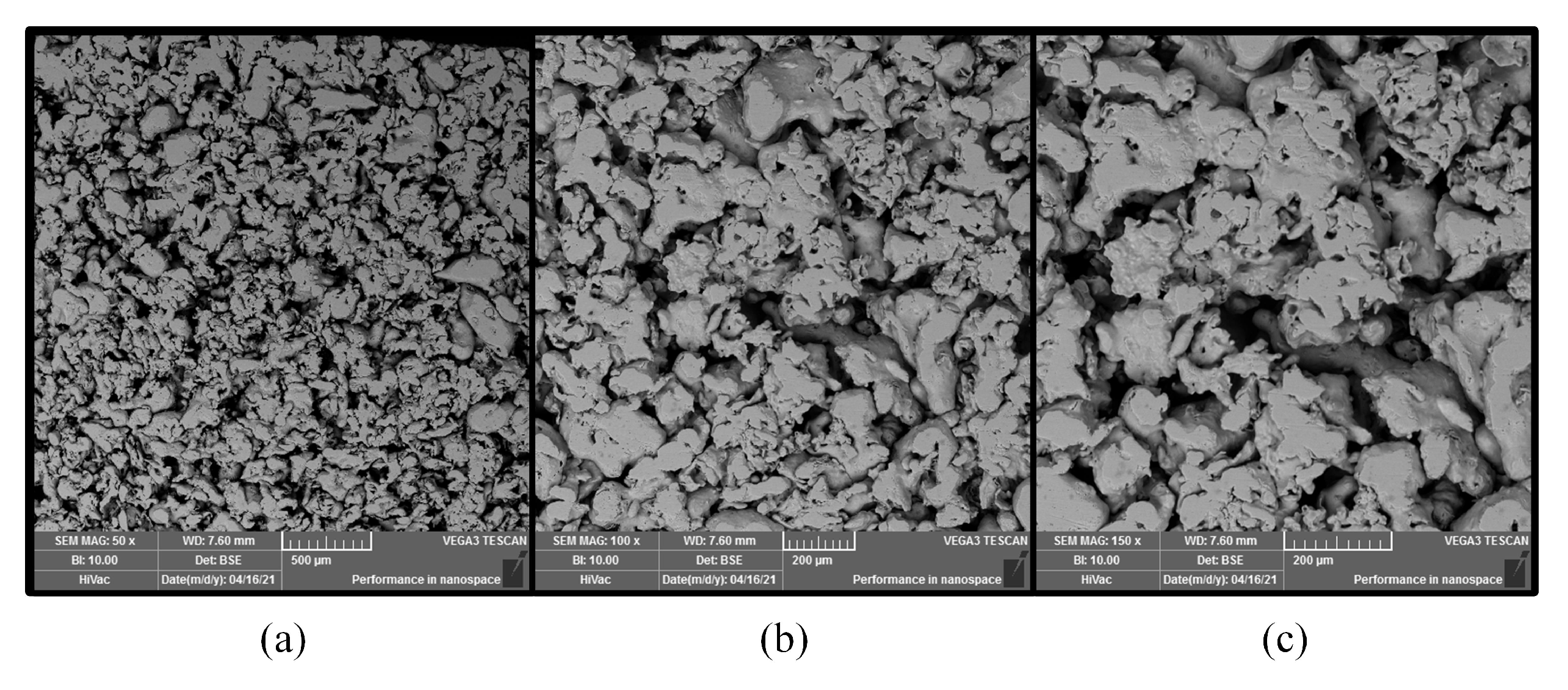

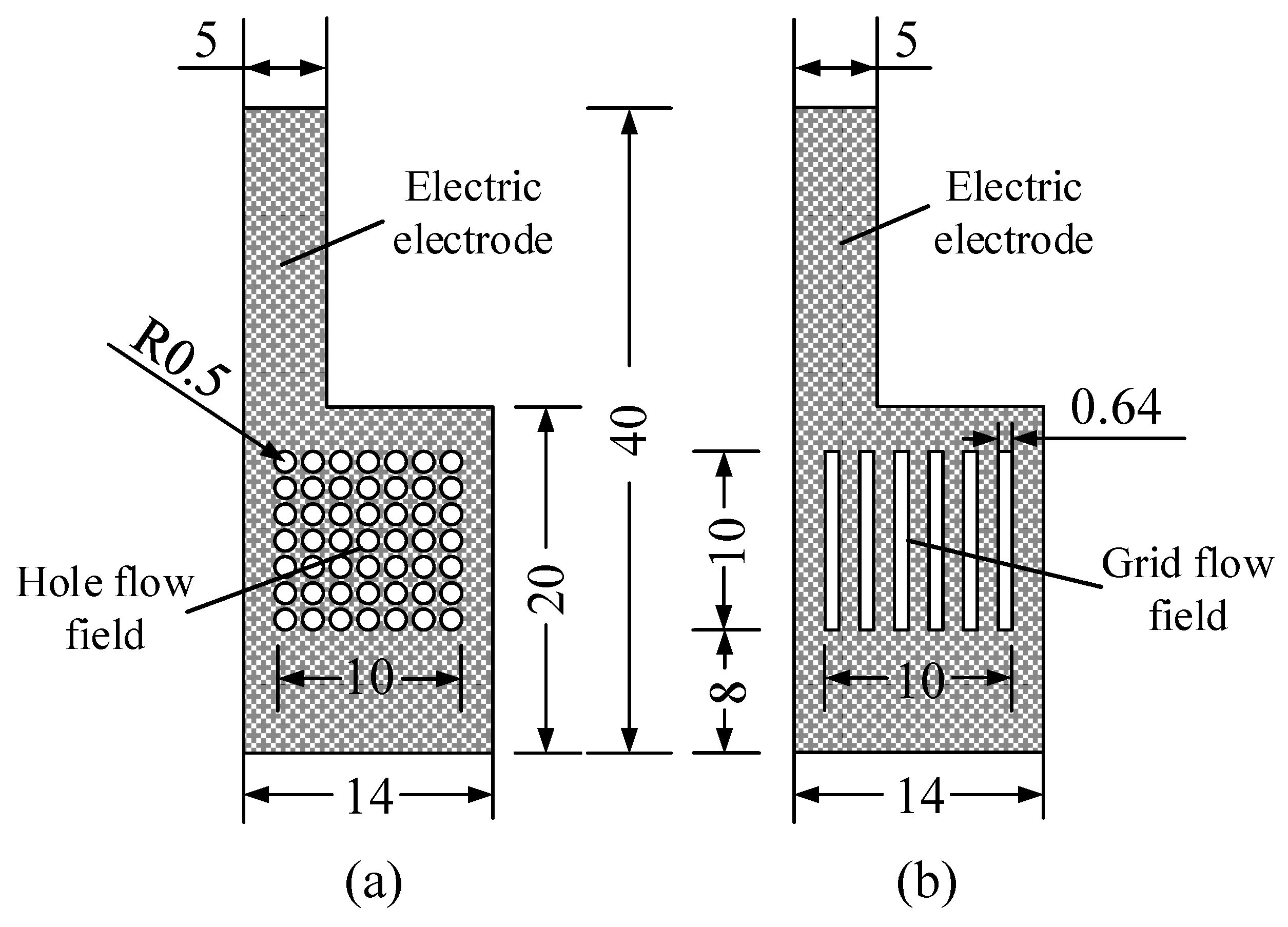
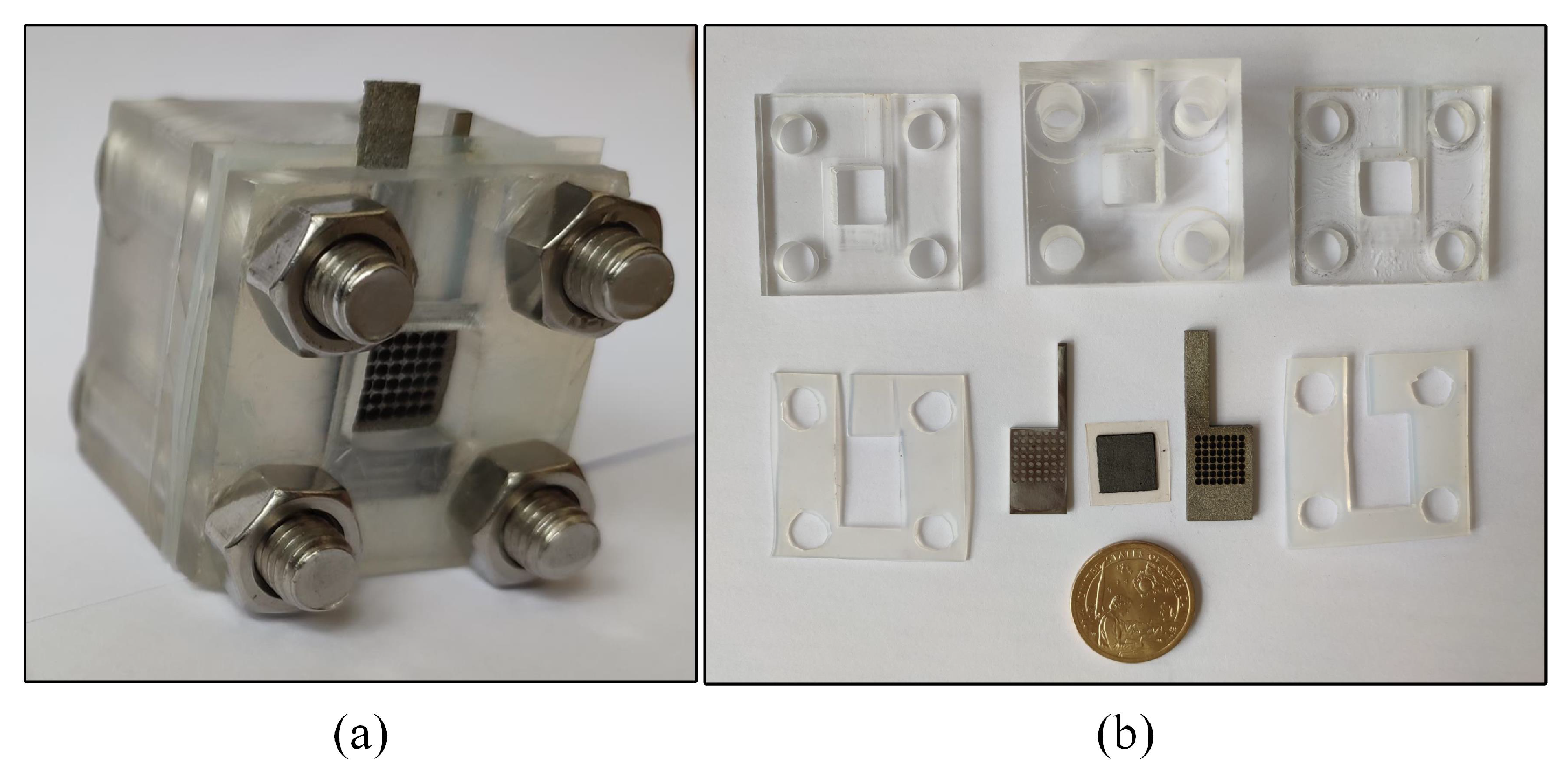

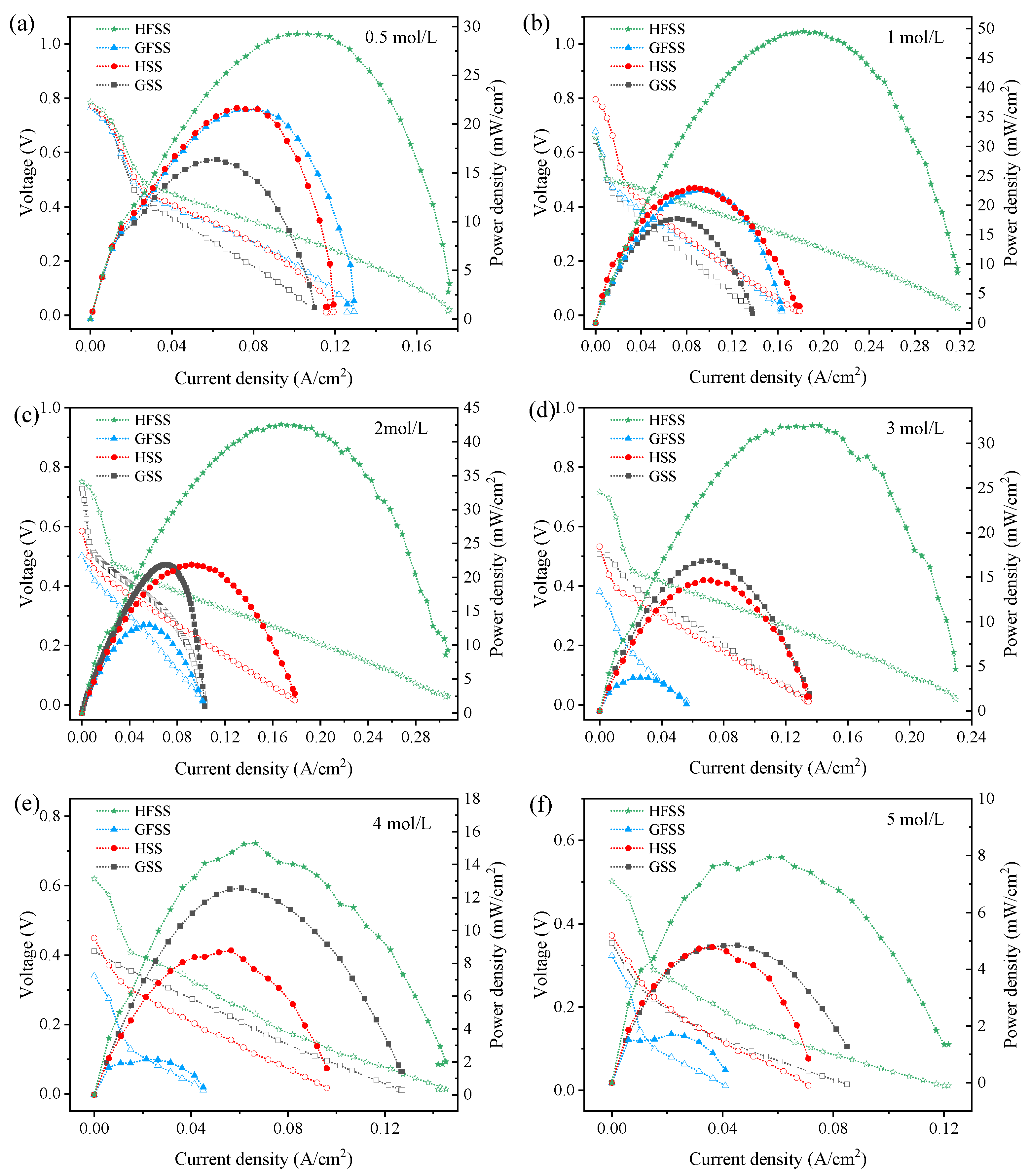

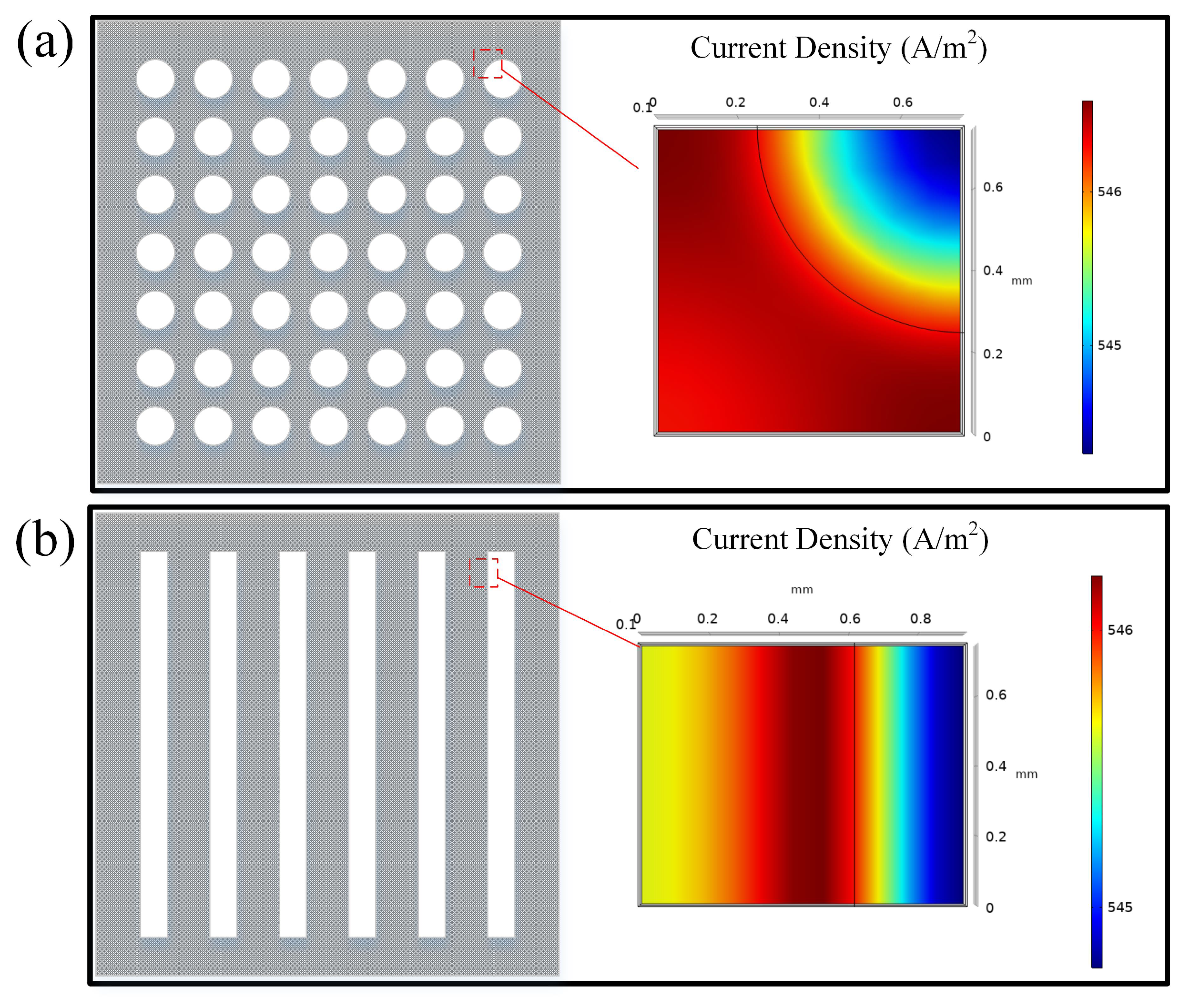
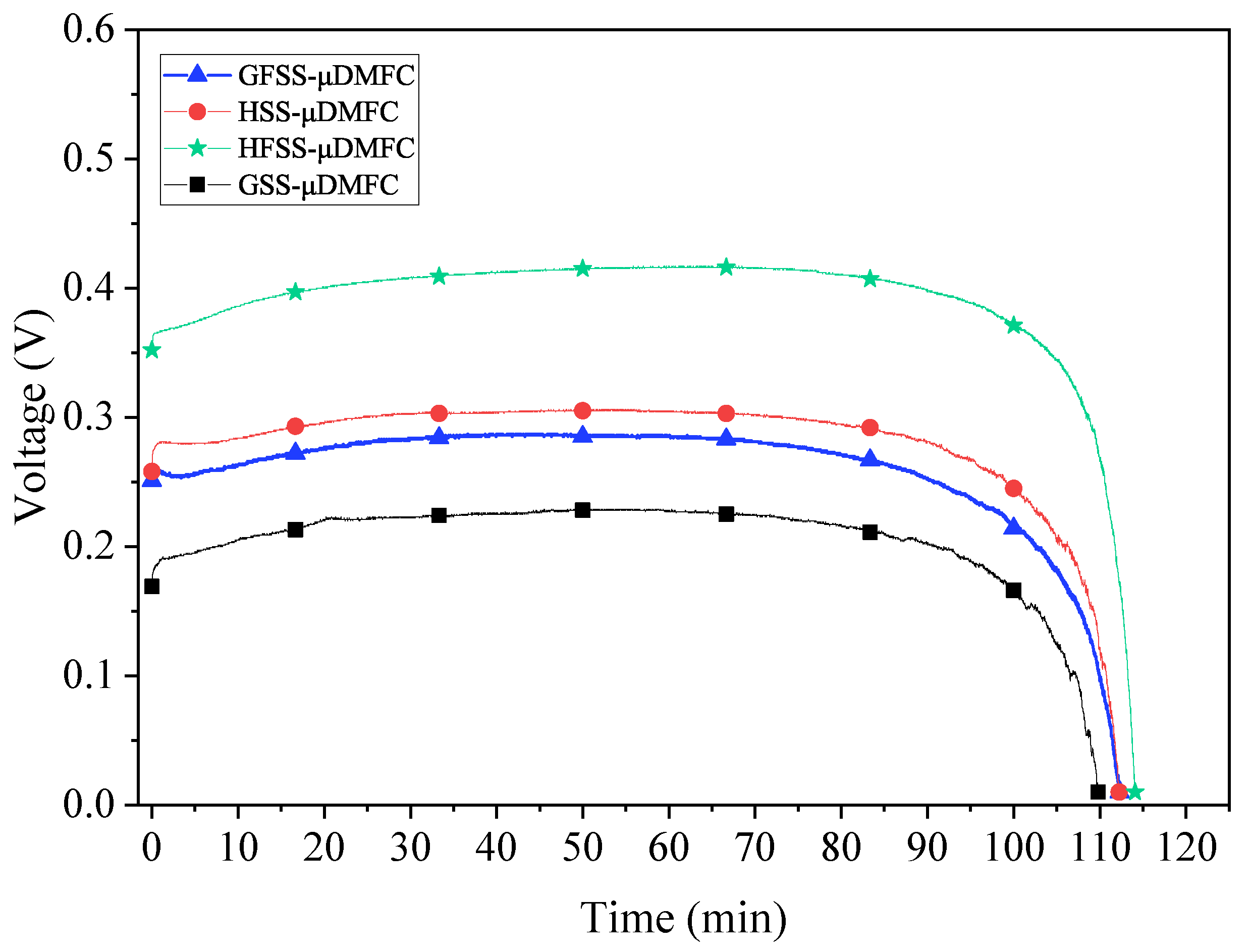

| Concentration mol/L | GSS | HSS mW/cm2 | GFSS | HFSS |
|---|---|---|---|---|
| 0.5 | 16.36 | 21.65 | 21.55 | 29.26 |
| 1 | 17.74 | 22.96 | 22.60 | 49.53 |
| 2 | 13.03 | 21.91 | 21.89 | 42.56 |
| 3 | 3.75 | 16.87 | 14.66 | 32.01 |
| 4 | 2.16 | 12.57 | 8.78 | 15.29 |
| 5 | 1.71 | 4.85 | 4.78 | 7.94 |
Publisher’s Note: MDPI stays neutral with regard to jurisdictional claims in published maps and institutional affiliations. |
© 2021 by the authors. Licensee MDPI, Basel, Switzerland. This article is an open access article distributed under the terms and conditions of the Creative Commons Attribution (CC BY) license (https://creativecommons.org/licenses/by/4.0/).
Share and Cite
Zhao, Z.; Zhang, F.; Zhang, Y.; Zhang, D. Performance Optimization of μDMFC with Foamed Stainless Steel Cathode Current Collector. Energies 2021, 14, 6608. https://doi.org/10.3390/en14206608
Zhao Z, Zhang F, Zhang Y, Zhang D. Performance Optimization of μDMFC with Foamed Stainless Steel Cathode Current Collector. Energies. 2021; 14(20):6608. https://doi.org/10.3390/en14206608
Chicago/Turabian StyleZhao, Zhengang, Fan Zhang, Yanhui Zhang, and Dacheng Zhang. 2021. "Performance Optimization of μDMFC with Foamed Stainless Steel Cathode Current Collector" Energies 14, no. 20: 6608. https://doi.org/10.3390/en14206608
APA StyleZhao, Z., Zhang, F., Zhang, Y., & Zhang, D. (2021). Performance Optimization of μDMFC with Foamed Stainless Steel Cathode Current Collector. Energies, 14(20), 6608. https://doi.org/10.3390/en14206608






